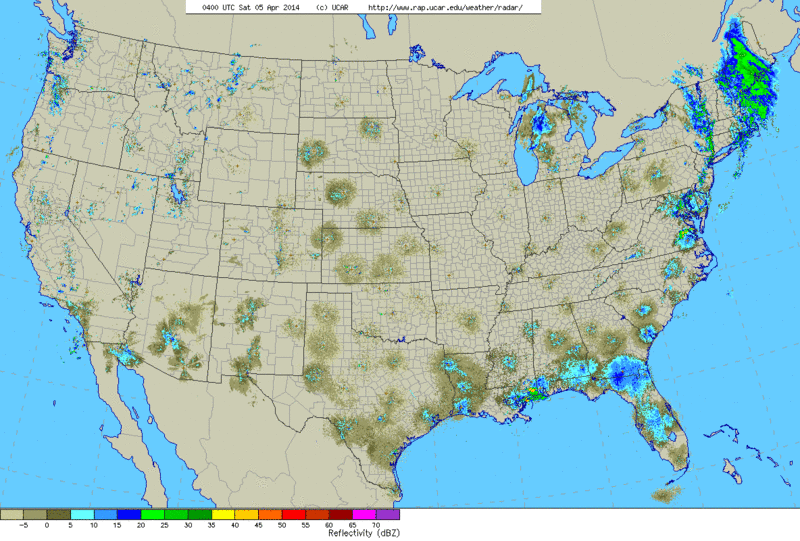Continental Summary
A nice pulse of moderate movements early to midweek in the West contrasted a pattern of late week moderate to locally heavy movements in the East. Species on the move this week included Hooded Merganser, Horned and Red-necked Grebes, Turkey Vulture, Broad-winged and Swainson’s Hawks, Ring-billed and California Gulls, Chimney Swift, Blue-gray Gnatcatcher, an array of warblers, Indigo Bunting, and an array of sparrows.
 West
West
Scattered light and locally moderate movements began the weekend in the Desert Southwest, despite mostly quiet on the migration front elsewhere in the region. By Sunday night movements became more extensive, extending up the Pacific Coast to Washington, increasing to moderate and locally heavy movements by Monday night. Following these movements, migrants continued at light to moderate levels from California south and east through the Desert Southwest to end the period, while more northerly reaches experienced much lighter and widely scattered movements. Note that early and midweek did see light to moderate movements expand into the Great Basin and northern Rockies, briefly. Species on the move this week included Swainson’s Hawk, American Avocet, Greater Yellowlegs, Franklin’s Gull, Ash-throated and Pacific-slope Flycatchers, Western Kingbird, Ruby-crowned Kinglet, Orange-crowned Warbler, and Yellow-headed Blackbird.
Great Plains
Scattered light movements highlighted an otherwise quiet Friday night to begin the period, building locally to moderate movements for Saturday night in eastern Kansas and Nebraska. As a disturbance passed through the region on Saturday and Sunday, the extent of these light to moderate movements varied across the region, finally shutting down by Monday night as unfavorable conditions followed the departure of low pressure. Tuesday and Wednesday nights saw pulses of moderate movements in the northern and then central and southern Plains, respectively, as another low pushed into the region. And as this low slowly pushed east, unfavorable conditions ended the period for much of the region, with only scattered light movements to the south and east of the pressure center. Species on the move this week included Wood Duck, Mallard, Ring-necked Duck, American White Pelican, Cattle Egret, Turkey Vulture, Northern Harrier, Osprey, Killdeer, Long-billed Dowitcher, California Gull, White-eyed Vireo, Grasshopper, Chipping, Field, Lark, Fox, White-crowned, and Harris’s Sparrows, Dark-eyed Junco, and American Goldfinch.
Upper Midwest and Northeast
The Friday departure of a low pressure center and its wet mess from the region opened the door for more favorable conditions to build into the region over the weekend, facilitating light to moderate movements. But another low came barreling through on Monday, shutting down movements and keeping them scattered and light through Tuesday night. Much improved conditions spawned moderate movements on Wednesday night, with favorable winds and temperatures returning to the Mississippi River valley and portions of the western Great Lakes. These movements were followed by widespread light and moderate movements from the southern Ohio River valley north and east into northern New England ahead of an approaching frontal boundary. Species on the move this week included Blue-winged Teal, Ring-necked Duck, Long-tailed Duck, Horned and Red-necked Grebes, Great and Double-crested Cormorants, Broad-winged Hawk, Northern Flicker, Barn, Tree and Northern Rough-winged Swallows, Hermit Thrush, Blue-gray Gnatcatcher, Ruby-crowned and Golden-crowned Kinglets, Palm Warbler, Chipping and Field Sparrows, and American Goldfinch.
Gulf Coast and Southeast
A frontal boundary kept most over land movements light and scattered for several days to begin the weekend, with the exception of heavier movements in Florida. However, numerous fallouts occurred as this frontal boundary pushed into the Gulf of Mexico. These conditions persisted until the middle of the week in many areas, with scattered precipitation, grounded trans-Gulf migrants, some Caribbean arrivals in Florida, and some scattered light to moderate over land migration all in the mix across the region. Not until Wednesday and Thursday nights side moderate and locally heavy movements return, first to the west of and then extending well to the east of the Mississippi River, respectively. Species on the move this week included Broad-winged Hawk, Ruby-throated Hummingbird, Chimney Swift, Great Crested Flycatcher, Red-eyed Vireo, Wood Thrush, American Robin, Worm-eating, Blue-winged, Black-and-white, Yellow-rumped, Kentucky, and Hooded Warblers, American Redstart, Orchard Oriole, Summer Tanager, Indigo Bunting, Blue Grosbeak, Savannah and Song Sparrows, and Dark-eyed Junco.




